-
past events
End-of-year Bookshop Sale Dec 13, 2025 - Dec 20, 2025
Eve Aboulkheir Lampo Performance Series Dec 06, 2025 Performance
Leila Bordreuil and Lee Ranaldo Lampo Performance Series Nov 08, 2025
Roc Jiménez de Cisneros Lampo Performance Series Oct 11, 2025
Concepción Huerta Lampo Performance Series Sep 27, 2025 Performance
Madlener House
4 West Burton Place
Chicago, Illinois 60610
Telephone: 312.787.4071
info@grahamfoundation.org

The Graham Foundation is pleased to debut the world premiere of Kjell Theøry by the experimental artist collective, ATOM-r (Anatomical Theatres of Mixed Reality). The performance is the culmination of a multi-year project by the group and joint residencies at the Graham Foundation and the International Museum of Surgical Science (IMSS). Presented in the historic Graham Foundation ballroom, the immersive, multimedia performances will take place over three weekends between January 20–February 4, 2017. Given the intimate scale of the presentation, seating for each performance is limited.
Performances will take place at 7PM on the following dates:
FRIDAY JAN 20 & SATURDAY JAN 21
FRIDAY JAN 27 & SATURDAY JAN 28
FRIDAY FEB 3 & SATURDAY FEB 4
Tickets are $15 each ($12 for students). Proceeds directly benefit ATOM-r.
Kjell Theøry is an Augmented Reality performance juxtaposing the writings of Alan Turing—a gay twentieth century computing pioneer—about pattern and shape in the natural world with algorithmic mutations of Guillaume Apollinaire’s 1917 play The Breasts of Tiresias, a gender fluid spectacle for which the playwright invented the word “surrealism.” The performance considers the last two years of Turing’s life wherein he expanded his focus to include biology while seeking asylum and tolerance in Scandinavia following his prosecution for crimes of indecency in the United Kingdom. Turing named his theory of morphogenesis—the autonomous generation of flowers and other natural forms—for a Norwegian love interest, Kjell.
In Kjell Theøry, ATOM-r draws on Turing’s theory, turning it into a poetic and choreographic system to blur the boundaries between the binaries of physical and virtual space, past and future, male and female, and human and machine. The collective’s process creates a deeply entangled and fertile exchange between the live body and ubiquitously distributed data-driven systems. A project-specific ecology of source material is translated as movement, visualized on screens, and mapped onto bodies and geo-physical space through locative and computer-vision based augmented reality. The performance uses coded systems and augmentation to create a liminal theatre evolved in relation to the Graham Foundation’s specific spatial context. While the work is inherently variable, it is experienced as a tightly constrained, yet flexible, information pattern that allows for close attention, emergence, and interruption.
The Graham Foundation residency program invites practitioners working in a wide range of disciplines to directly engage the physical spaces of the Foundation’s historic Madlener House. Residencies encourage and expand the discourse around architecture by providing resources and opportunities for collaboration within the Graham Foundation community. ATOM-r’s residency began in September 2016 in collaboration with IMSS, where the group simultaneously developed an exhibition entitled Kjell Theøry: Prologue. The exhibition at IMSS will run from January 20–February 26, 2017.
ATOM-r (Anatomical Theatres of Mixed Reality) is a provisional collective exploring forensics, anatomy, and twenty-first century embodiment through performance, language, and emerging technologies. The work is interdisciplinary and evolves through large-scale projects with long durations of research and practice that generate outputs across a range of platforms including Internet art, augmented reality, site specific installation, choreographed movement, books, and objects.
ATOM-r was conceived in response to the historical architecture of early modern anatomical theaters, spaces designed for viewing human dissections and early surgical procedures. This physical and conceptual arrangement is used as a symbol throughout their work to explore histories and experiences of the body, sexuality, and prosthesis.
Kjell Theøry was created by ATOM-r core members: Mark Jeffery (choreography) and Judd Morrissey (text and technology) with Justin Deschamps and Christopher Knowlton (collaborators/performers); and features a guest appearance by Leonardo Kaplan.
Collaborators include: Grace DuVal (costumes); Laura Prieto-Velasco, Stephen Reynolds, Oli Watt (props/objects); Joshua Patterson (sound); and Josh Hoglund (lighting).
ACCOMPANYING EXHIBITION
Kjell Theøry: A Prologue
Anatomical Theatres of Mixed Reality (ATOM-r)
January 20, 2016 – February 26, 2017
International Museum of Surgical Science
1524 N. Lake Shore Drive, Chicago, IL 60610
ATOM-r is supported by a joint residency at the International Museum of Surgical Science and the Graham Foundation for Advanced Studies in the Fine Arts, with additional support from The School of the Art Institute of Chicago.
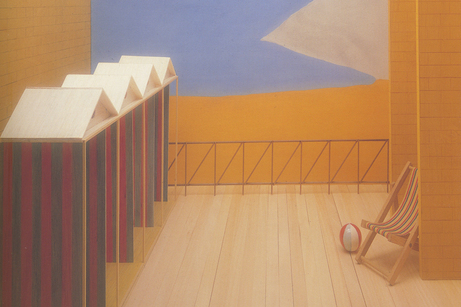
Aldo Rossi, Teatrino Scientifico, Scena con cabine, 1978. Courtesy of the Fondazione Rossi.
Please join us for a reception and talk by curators Ruth Estévez and Wonne Ickx to celebrate the opening of our new exhibition, Spaces without drama or surface is an illusion, but so is depth.
Thursday, February 16, 2017
6pm: Talk by Ruth Estévez and Wonne Ickx
7-8pm: Opening Reception
LIGA–Space for Architecture, is an independent initiative founded in Mexico City that promotes contemporary architecture through exhibitions, conferences, publications, and events, with a focus on Latin America. As a curatorial platform LIGA strives to expand the architectural discipline as a discursive practice, to experiment with exhibition and presentation formats, and to establish connections with other disciplines. LIGA was co-founded by Carlos Bedoya, Ruth Estévez, Wonne Ickx, Victor Jaime, and Abel Perles in 2011. Isabel Martínez Abascal joined LIGA as program director in in 2015.
Ruth Estévez (b. 1977. Bilbao, Spain) is a writer, curator and set designer based in Los Angeles, where she is currently the director and curator of REDCAT/CalArts Gallery. Between 2007 and 2011, Estévez served as the chief curator at the Museo de Arte Carrillo Gil, Mexico City, where she organized exhibitions of Mark Manders, Fernando Ortega, Guy Ben-Ner, among others. In 2011 Estévez cofounded LIGA, Space for Architecture in Mexico City, an exhibition platform dedicated to experimentation in the field of architecture and urbanism. Her current work at REDCAT has brought to Los Angeles artists like Javier Téllez, Pablo Bronstein, Allora & Calzadilla, Pedro Barateiro, and Quinn Latimer, as well as such group exhibitions as Agency. Assembly: Before and After the Split second recorded (2015) and Small Museum for the American Metaphor (2014) co-curated with Kersten Geers. She has written for numerous exhibition 3 catalogues and art publications and has independently organized exhibitions in Spain, France, Belgium, and the United States, as well as in Mexico.
Wonne Ickx founded PRODUCTORA in Mexico City, together with Abel Perles, Carlos Bedoya, and Victor Jaime in 2006. PRODUCTORA was awarded the Architectural League Prize in 2007 and the Emerging Voices Competition in 2013. In 2016 the studio received the Mies Crown Hall Americas Prize for Emerging Architects from the Illinois Institute of Technology (IIT) College of Architecture. Among the office’s many publications, the monographs published by Arquine in 2010 and 2G in 2014 summarize the work over this intense period of production. Ickx teaches at several universities in Mexico City, as well as the University of California Los Angeles (UCLA), IIT, and Harvard. He is one of the founding directors of LIGA, Space for Architecture.
The Graham would like to thank Perrier for supporting our public programs.
For more information on the exhibition, Spaces without drama or surface is an illusion, but so is depth , click here.
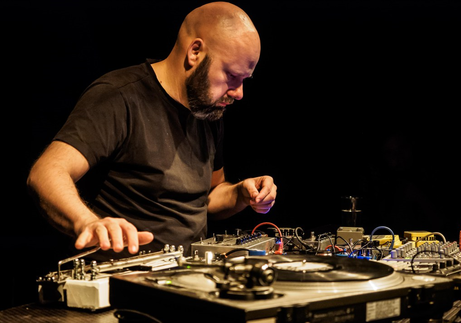
Norwegian artist Lasse Marhaug return to Chicago with two new, eight-channel compositions commissioned by Lampo. Marhaug premieres "Saltfjorden Vapor"—constructed from a mix of location recordings from Saltstraumen (one of the strongest tidal currents in the world), acoustic objects, voice, ARP Odyssey synthesizer and optical sound from 16mm film projectors.
In "The First Eight," Marhaug combines his electronics with recorded acoustic material from musicians Stine Janvin Motland (voice), Martin Taxt (tuba), and the trio Sult (percussion, acoustic guitar and double bass). This performance is the U.S. premiere of the work, which was originally composed at the request of INA-GRM for the Présences and L’Audible festivals in Paris in the spring of 2016.
Lasse Marhaug (b.1974, Bodø, Norway) has been one of the primary forces and most prolific figures in the Norwegian noise scene since the early 1990s. He has contributed to more than 300 releases and toured extensively throughout Europe, North America and Asia. Collaborators include Merzbow, Sunn O))), Maja Ratkje, Okkyung Lee, Kommissar Hjuler und Frau, The Skull Defekts and John Wiese, and Chicagoans Kevin Drumm and Ken Vandermark. While Marhaug is perhaps most known for his work in noise, he also ventures into improvisation, jazz, rock and extreme metal. He has contributed music to theater, film and video as well. Since 2011 he has published his fanzine Personal Best, in which he interviews his favorite artists. He also works as a producer and promoter, and runs the record labels TWR Tapes, Pica Disk and Prisma Records. Marhaug lives in Bodø, a city above the Arctic Circle in Norway.
This performance is presented in partnership with Lampo. Founded in 1997, Lampo is a non-profit organization for experimental music and intermedia projects. Support provided to Lampo by mediaThe foundation inc.
Image courtesy of Thor Egil Leirtro.
The Graham would like to thank Perrier for supporting our public programs.

'Photographs of Trinidad and Tobago (1964)’ by Daphne Oram & ‘In the Background’ by Céline Condorelli & James Langdon in Bricks from the Kiln #2
Join the Graham Foundation Bookshop for the launch of Bricks from the Kiln #2, a publication by Andrew Lister and Matthew Stuart. Taking place as part of a Saturday series of Graham Foundation bookshop events, this launch will feature a reading from Bricks from the Kiln #2 and discussion between Lister and Chicago typographer Pouya Ahmadi. The launch will be followed by a reception in the bookshop with drinks and copies of Bricks from the Kiln #1 and #2 for sale.
Bricks from the Kiln borrows its title from the glossary notes of Ret Marut's Der Ziegelbrenner, which was the 'size, shape and colour of a brick,' and ran for 13 issues between 1917 and 1921. Like the first issue, Bricks from the Kiln #2 is still ‘tentative, incomplete and inconsistent’ and still ‘in flux and liable to crack.’
Bricks from the Kiln #2 presents its material ‘reordered, recontextualised and reclassified, freed from the archive and fragmented on these pages,’ and includes contributions from Ryan Gerald Nelson, James Bulley, Daphne Oram, Céline Condorelli, James Langdon, Scandinavian Institute for Computational Vandalism, Mark Simmonds, David Whelan, Ron Hunt and Rose Gridneff. Highlights from this issue include pieces on the sound-film work of Daphne Oram and Geoffrey Jones; monuments to Kazimir Malevich, Rosa Luxemburg and Walter Benjamin; the relocation of a defunct bookshop from Amsterdam to Epsom; a conversation on the politics of display and ‘Agatha Christie smoking Asger Jorn’s cigar.’
Bricks from the Kiln #2 is bound with ‘signature-wrap’ prints bookending each eight-page section. Each copy comes complete with an inserted index and afterword in a screen-printed PVC dust jacket.
Bricks from the Kiln is edited and designed by Andrew Lister and Matthew Stuart between Chicago and London.
Pouya Ahmadi is a Chicago-based typographer and educator. He is an Assistant Professor of Graphic Design at the University of Illinois at Chicago and editorial board member of Neshan magazine.
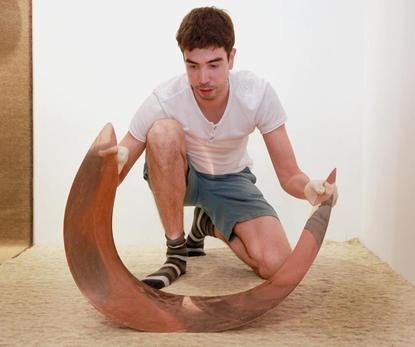
Sergei Tcherepnin premieres a new composition for various electronics played through an ensemble of cardboard and aluminum speakers. This work is an expansion of earlier works of his such as Giving Rein, in which he used 38 channels to articulate a spatial sonic architecture that was constantly in flux.
Sergei Tcherepnin (b.1981, Boston, Mass.) is an artist operating at the intersections of sound, sculpture, and theater. Attaching synthesizers, computers and amplifiers to small surface transducers—devices that convert electrical signals into vibrations—he orchestrates complex multi-channel compositions in which objects are transformed into speakers. Often invoking queer, hybridized characters such as the Listening Cactus, the Maize Mantis, or the figure of the Pied Piper, Tcherepnin’s scenarios cultivate play between things and bodies, compelling the audience to develop a “score” for handling these animated objects. These interactions suggest new possibilities for intimacy with sound, where “listening” involves a more expansive state of activity: listening by touching, listening by opening, listening by feeling, listening by harnessing, or listening by walking.
His recent performances and installations include the Museum der Moderne, Salzburg; Overduin & Co., Los Angeles; Whitney Biennial, Whitney Museum of American Art, New York; Roulette, New York; the Museum of Modern Art, New York; Pavilion of Georgia at the 55th Venice Biennale; Murray Guy, NY; the Kitchen, NY; Yvon Lambert, Paris; Karma International, Zurich; Solomon R. Guggenheim Museum, NY; and the 30th São Paulo Biennial, Brazil. He is a recipient of 2014 Villa Romana Fellowship in Florence, Italy.
Artist Talk: Friday, March 10, 6pm. Lampo Annex, Monadnock Building, 53 W. Jackson Blvd. #1656.
Sergei Tcherepnin discusses the influence of late artist Maryanne Amacher on his work. He will describe his recent project at the Stedelijk Museum as a part of Supreme Connections, a collective of artists, musicians and researchers devoted to interpreting and presenting the ideas of Amacher. Tcherepnin also will consider Amacher’s notion of “sound characters” and explain how her extensive research on sound and the body relates to his exhibitions Subharmonic Lick Thicket, Ear Tone Box and Games as well as his large-scale performance piece Maize Mantis.
This performance is presented in partnership with Lampo. Founded in 1997, Lampo is a non-profit organization for experimental music and intermedia projects.
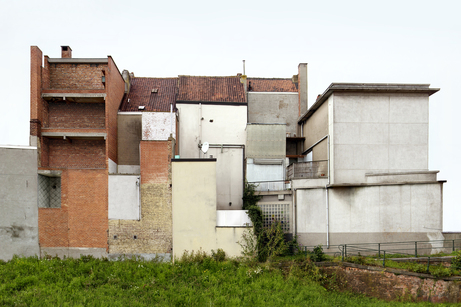
Filip Dujardin, Untitled, from the Fictions Series.
On the occasion of our current exhibition, Spaces without drama, Jesús Vassallo discusses his recent research and publication, Seamless: Digital Collage and Dirty Realism in Contemporary Architecture (Park Books, 2016), exploring the realist drive underlying contemporary collaborations between artists and architects in Central Europe.
Jesús Vassallo is a Spanish architect and writer, and currently an assistant professor at Rice University in Houston, Texas. His work interrogates the problem of realism in architecture through the production of design and scholarship. He is the author of Seamless: Digital Collage and Dirty Realism in Contemporary Architecture and is currently finishing a second manuscript titled Epics in the Everyday. His articles have been published internationally in magazines such as AA Files, 2G, Log, Harvard Design Magazine, Future Anterior, Domus, Arquitectura Viva, and Arkitektur DK; Vassallo also serves as editor for Circo magazine.
Related Graham Foundation supported projects:
For more information on the exhibition, Spaces without drama or surface is an illusion, but so is depth , click here.
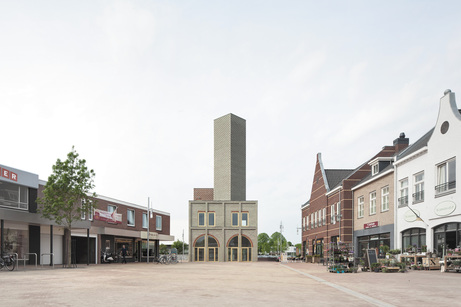
Monadnock, "Marketsquare," Nieuw Bergen, 2015. Photo: Stijn Bollaert.
Job Floris, architect and co-founder of the Dutch architecture firm Monadnock, will present a talk about the firm's practice and their participation in Spaces without drama or surface is an illusion, but so is depth, on view at the Graham Foundation February 16–July 1, 2017.
Monadnock is a Rotterdam-based architecture practice led by Job Floris and Sandor Naus. Monadnock designs, researches, writes, and produces discourse in the fields of architecture, urbanism, interiors, and staging. Their work shifts between the scale of the city, the street, and the interior. Monadnock creates contemporary buildings that embed architecture in the cultural production of their generation as a whole. By examining key themes such as the contemporary and tradition, convention and banality, constructive logic, and illusionary representation, Monadnock aims for an architecture that combines beauty, efficiency, and the transfer of architectural knowledge. Landmark, Monadnock's viewing tower project developed for the municipality of Nieuw Bergen (NL), was shortlisted for the 2017 Mies van der Rohe Award.
For more information on the exhibition, Spaces without drama or surface is an illusion, but so is depth , click here.
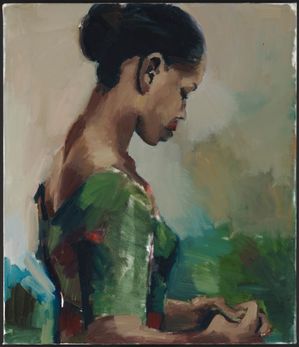
Lynette Yiadom-Boakye, "The Work," 2015. Oil on canvas.
As part of our continuing collaboration with Northwestern University's Department of Art, Theory, Practice, the Graham Foundation is pleased to host a talk by artist and writer Lynette Yiadom-Boakye.
Lynette Yiadom-Boakye is an artist and writer of Ghanaian descent based in London. She is represented by the Corvi-Mora Gallery in London and Jack Shainman Gallery in New York. Her work is included in the permanent collections of a number of institutions including the Tate Collection, London; the Victoria and Albert Museum, London; the Miami Art Museum; the Studio Museum in Harlem; the Museum of Contemporary Art Chicago; the Nasher Museum of Art, Durham, NC; The Museum of Modern Art, New York; the San Francisco Museum of Modern Art; the National Museum of African Art; and the Museum of Modern Art Warsaw. Recently she has mounted solo shows at the Serpentine Gallery, London (2015); Haus der Kunst, Munich (2015); Kunsthalle Basel, Switzerland (2016–17); and the New Museum, New York (May 2017). In 2006, Yiadom-Boakye won the Arts Foundation Fellowship for Painting. In 2012, she won the New Museum's Pinchuk Foundation Future Generation Prize, and in 2013 was shortlisted for the Turner Prize for her 2012 exhibition at Chisenhale Gallery in east London.
This lecture is part of the Department of Art, Theory, Practice at Northwestern University Visiting Artist Lecture Series, and is made possible with generous support from The Myers Foundations and the Jerrold Loebl Fund for the Arts.
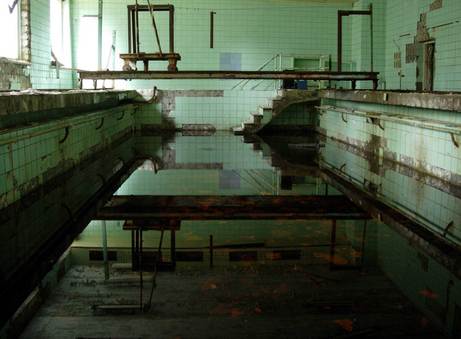
Jacob Kirkegaard, “AION,” 2016.
In his first Chicago performance, Jacob Kirkegaard presents AION, recorded and filmed in four abandoned spaces inside the radioactive zone around the former nuclear power plant in Chernobyl, Ukraine.
AION—infinity or eternity in ancient Greek—was inspired by the groundbreaking sound work I am sitting in a room (1969), by artist Alvin Lucier, in which Lucier recorded himself saying, “I am sitting in a room, different from the one you are in now. I am recording the sound of my speaking voice.” He then played these phrases back and recorded them again, until the different layers of his voice began to merge. Kirkegaard has taken Lucier’s action a step further, recording the resonance of an empty swimming pool, concert hall, gymnasium, and church, inside the Chernobyl exclusion area.
Kirkegaard put up a microphone and speaker in each space, started the recording, and left. After ten minutes, he returned, stopped the recording, played it back into the same room, and made a new recording. With each new layer, subtle sounds enlarged and deepened until they turned into one rich hum with many overtones. In effect, he has recorded the voices of rooms.
Jacob Kirkegaard (b.1975, Esbjerg, Denmark) is an artist focused on the scientific and aesthetic aspects of resonance, time, sound, and hearing. His installations, compositions, and performances deal with acoustic spaces and phenomena that usually remain imperceptible. Using unorthodox recording tools, including accelerometers, hydrophones, and home-built electromagnetic receivers, Kirkegaard captures and contextualizes previously unheard sounds from a variety of environments: a geyser, a sand dune, an empty room, a glacier, and even the human inner ear itself.
Based in Berlin, Kirkegaard is a graduate of the Academy for Media Arts in Cologne. He has presented his works at exhibitions, festivals, and conferences throughout the world, including the Museum of Modern Art, New York; Louisiana Museum of Modern Art, Denmark; KW Institute for Contemporary Art, Berlin; Museum of Contemporary Art, Denmark; the Menil Collection, Houston; Rothko Chapel, Houston; Aichi Triennale, Nagoya; and the Mori Art Museum, Tokyo. He has released several albums on Touch, Important Records, and other labels. He is also a member of the sound art collective freq_out.
On Friday, April 7, 6 p.m, Kirkegaard will also give an artist talk in conjunction with this performance at the Lampo Annex, Monadnock Building, 53 W. Jackson Boulevard #1656, to discuss his audio-video work in Chernobyl as well as similar projects in Fukushima and other nuclear power plants. RSVP here
Since 2010 the Graham Foundation has supported and partnered with Lampo to produce this performance series held at the Madlener House. Lampo, founded in 1997, is a non-profit organization for experimental music and intermedia projects.

Stanley Kubrick, [Commodities traders on the floor of the Chicago Board of Trade], Look, 1949
Despite having never visited the city, Chicago was an obsession for Bertolt Brecht (1898–1956). He viewed Chicago as a metropolis built on sheer rationality and steel-frames, grain-silos and financial speculation, infrastructure and industrial monopolies, nomad workers and labor struggles—the material expression of the most advanced forces of capitalism. Brecht allegorically adopted such a jungle of asphalt, railways, skyscrapers, primitive drives, and frantic activities to stage most of his early plays. By dissecting reality “like the mechanism of a car,” Brecht’s theatre rejected any emphatic representation of the world, aiming instead to unravel the conditions which produce the world. This talk reads the architecture of production in Chicago through the eyes of Bertolt Brecht, adopting the principles of estrangement, dialectical theatre, and montage as design tools for conjecturing a series of projects for The Resistible Rise of Arturo Ui.
Francesco Marullo holds a MS and PhD in History and Theory of Architecture from Delft University of Technology (TU Delft) and The Berlage Center for Advanced Studies in Architecture and Urban Design in Rotterdam. He is a founding member of the research collective The City as a Project (2010), and his work focuses on the relation between architecture, logistics, and production. Marullo is the 2016–17 Douglas A. Garofalo Fellow and Visiting Assistant Professor at the UIC School of Architecture. Previously, he taught at The Berlage, TU Delft, the Rotterdam Academy of Architecture, the RomaTre University, and also collaborated with the Office for Metropolitan Architecture, Matteo Mannini Architects, and DOGMA. In 2012 he cofounded Behemoth Press—a think-tank platform devoted to the exploration of the architectural project in the form of essays, drawings, exhibitions, symposia, and publications.
About the Douglas A. Garofalo Fellowship
Named in honor of architect and educator Doug Garofalo (1958–2011), this nine-month teaching fellowship—supported with a grant from the Graham Foundation—provides emerging designers the opportunity to teach studio and seminar courses in the undergraduate and graduate programs and conduct independent design research. The fellowship also includes a public lecture at the Graham Foundation and an exhibition at the UIC School of Architecture. To learn more about the fellowship, click here.
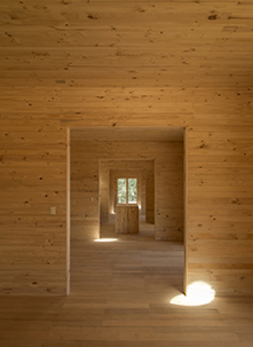
Pezo von Ellrichshausen, "Casa Meri," Florida, Chile, 2014. Photo courtesy Pezo von Ellrichshausen.
In conjunction with the Graham Foundation’s current exhibition, Spaces without drama or surface is an illusion, but so is depth, Mauricio Pezo and Sofia von Ellrichshausen discuss their work and participation in the show, including No More No Less, a multi-year project in which the architects represent their work within the rooms of a miniature museum.
Through a selection of Pezo von Ellrichshausen’s buildings, paintings, drawings, photographs, and scale models, the lecture explores the fundamental—yet diffuse—distinction between presence and representation.
Pezo von Ellrichshausen is an art and architecture studio founded in 2002 in Concepción, Chile, by Mauricio Pezo and Sofia von Ellrichshausen. They currently teach at the Universidad Catolica in Santiago and at the Illinois Institute of Technology in Chicago. They have lectured at the Tate Modern, London; the Victoria & Albert Museum, London; the Metropolitan Museum of Art, New York; the Alvar Aalto Symposium; and Harvard University’s Graduate School of Design, Cambridge; among other venues. In 2008 they curated the Chilean Pavilion at the Venice Biennale.
For more information on the exhibition, Spaces without drama or surface is an illusion, but so is depth , click here.
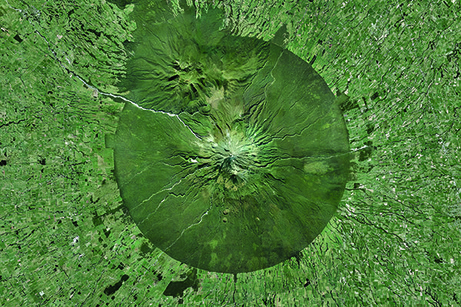
Image: Mount Taranki, Egment National Park, New Zeland, 2007. Courtesy of Google Earth (Image Taranaki Regional / Stratfod / South Taranaki Councils).
Join the editors of the Harvard Graduate School of Design’s New Geographies to launch its most recent issue, New Geographies 08: Island, in conjunction with the journal’s tenth anniversary of discourse and discovery. An “atlas” of islands, New Geographies 08 explores the new limits of islandness and gathers examples to reassert its relevance for design disciplines.
The panel will present the three most recent editions, conceived as a trilogy concerned with revealing the geographic imprints of metabolic, technological, and systemic processes: New Geographies 06: Grounding Metabolism; New Geographies 07: Geographies of Information; and New Geographies 08: Island. The editors will also unpack the journal’s broader intellectual agenda and discuss its future.
New Geographies examines the emergence of the geographic—a new, but for the most part latent, paradigm in design today. Through critical essays and design projects, the journal explores the expanded agency of the designer, as well as agency as a form of capacity in relation to new techniques and strategies, and a faculty of acting, power, and disciplinary repositioning. The journal is produced by doctoral candidates at the Harvard Graduate School of Design (GSD) and is made possible through the support of the Office of the Dean at GSD and the Graham Foundation for Advanced Studies in the Fine Arts. It is distributed by Harvard University Press. The current editorial board consists of Daniel Daou, Ali Fard, Daniel Ibañez, Nikos Katsikis, Taraneh Meshkani, and Pablo Pérez-Ramos; the upcoming issue will be edited by Mariano Gomez Luque and Ghazal Jafari.
NEW GEOGRAPHIES 08: ISLAND
Editors: Daniel Daou & Pablo Pérez-Ramos
Daniel Daou is a doctor of design candidate at the Harvard University’s GSD. He holds a BArch from the Universidad Iberoamericana, where he graduated at the top of his class in 2006. He was a visiting scholar at SCI-Arc, a fellow for the National Council for Science and Technology, and was recognized as a “Young Talent” by the National Fund for Culture and Arts. In 2011, with the support from the Fulbright Program and the Brockman Foundation, he obtained an MS in architecture studies and a master’s degree in city planning with an urban design certificate from MIT.
Pablo Pérez Ramos is a licensed architect and a landscape architect from Madrid. He received a professional degree in architecture from the ETSAMadrid in 2006, and a master’s degree in landscape architecture from Harvard University’s GSD in 2012. Recently, he has received Harvard University’s GSD Dean's Merit Scholarship, the Fundación Caja Madrid Scholarship, and the Fundación La Caixa Scholarship. He has taught at ETSAMadrid, and the Boston Architectural College. At the GSD, he is currently a teaching fllow in the Urban Design Department and the Landscape Architecture Department, and research associate at the New Geographies Lab.
NEW GEOGRAPHIES 07: GEOGRAPHIES OF INFORMATION
Editors: Ali Fard & Taraneh Meshkani
Ali Fard is a doctoral candidate at Harvard University’s Graduate School of Design, where he is coeditor of the New Geographies journal and a research associate at the Urban Theory Lab. Fard's current work deals with the operational networks of connectivity, the urban and spatial disposition of information and communication technologies, and the extended agency of design in contemporary processes of urbanization. His work and writing have been featured in MONU, Bracket, Azure, MAS Context, and Conditions.
Taraneh Meshkani is an architect and a doctor of design candidate at Harvard University’s Graduate School of Design. She is also a doctoral fellow in the Harvard Graduate Consortium on Energy and Environment. Meshkani received her MArch from the University of Toronto and her BArch from Azad University of Tehran. She has worked as a teaching fellow and research associate at the GSD. Meshkani has received many awards, such as the Professional Experience Program Award from Morphosis Architects; the 2009–10 Toronto Society of Architects Scholarship; and the 2010 Canadian Architect Student Award of Excellence (for her thesis project).
NEW GEOGRAPHIES 06: GROUNDING METABOLISM
Editors: Daniel Ibanez & Nikos Katsikis
Daniel Ibáñez is a licensed architect by the Escuela Politécnica de Madrid with distinction (ETSAM, 2007), and holds a master’s degree in advanced architecture from the Institute for Advanced Architecture of Catalunya (IAAC, 2008). In 2012, he completed a master’s degree in design studies in urbanism, landscape, and ecology at the GSD as a fellow and Fulbright Scholar from the Fundación La Caixa, where he awarded the Dimitris Pikionis Award for best academic performance in his program. Ibáñez is currently affiliated with the GSD as a doctor of design student, where he is currently developing his thesis on metabolic urbanism.
Nikos Katsikis is an architect, urbanist, and doctor of design candidate (DDeS) at Harvard University’s Graduate School of Design, where he is research associate at New Geographies Lab and Urban Theory Lab. He has worked as a teaching fellow at the GSD and the National Technical University Athens (NTUA), and has instructed studios at Amsterdam Academy of Architecture. He is a registered architect in Greece (2006), where he was an associate architect with Sakelaridou and Papanikolaou Architects. He holds a professional degree in architecture with highest distinction (2006) and an MS in architecture and spatial design (2009) from NTUA.
Related Graham Foundation supported projects:
2009 Publication Grant to Harvard University–Graduate School of Design for New Geographies 02: Landscapes of Energy and New Geographies 03: Urbanisms of Color
2011 Publication Grant to Harvard University–Graduate School of Design for New Geographies 05: The Mediterranean and New Geographies 06: Grounding Metabolism
2014 Publication Grant to Harvard University–Graduate School of Design for New Geographies 07: Information Geographies and New Geographies 08: Islands
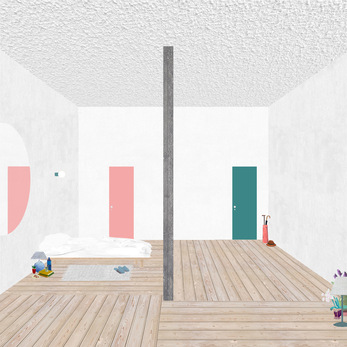
fala atelier, São Brás apartment, 2017. © fala atelier
Filipe Magalhães, architect and co-founder of the architecture firm fala atelier, presents a talk about the firm's practice and their participation in the Graham Foundation’s current exhibition, Spaces without drama or surface is an illusion, but so is depth. Join us as fala atelier explores perspectives on collage and the allusion to portraiture in their work. The conversation begins with the assertion that each portrait tells a short story and continues with explorations of what is feasible within the medium.
fala atelier is an architecture firm founded in 2013 by Filipe Magalhães, Ana Luisa Soares, and Ahmed Belkhodja. The group describes themselves as a naïve architecture practice based in Porto, Portugal. Tackling a wide range of projects, from renovations to bird houses, fala engages with architectural questions through the built environment, public engagement, exhibitions, and academics.
For more information on the exhibition, Spaces without drama or surface is an illusion, but so is depth , click here.
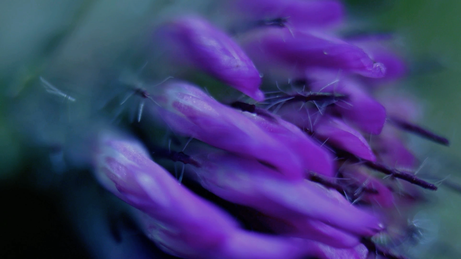
Phill Niblock, "Meudrone1," 2013
Join us for the debut of recent work by the great minimalist composer Phill Niblock in his first Chicago performance in more than eight years. Niblock constructs 24-track digitally-processed, monolithic, microtonal drones, and describes the intention of his music as “produce[ing] something without rhythm or melody, by using many microtones that cause movements very, very slowly.”
The two-hour program in the Graham Ballroom includes the following recorded works: FeedCorn Ear (2012) with Arne Deforce, cello; Bag (2014) with David Watson, bagpipes; Praised Fan (2016) with Dafne Vicente-Sandoval, bassoon; Ronet (2014) with Neil Leonord, tenor saxophone; V&LSG (2015) with Lore Lixenberg, voice, and Guy De Bièvre, lap steel guitar; and Vlada BC (2013) with Elisabeth Smalt, viola d’amore. Cellist Fred Lonberg-Holm joins Niblock to play live on FeedCorn Ear.
In keeping with other Niblock performances, his films and videos accompany this presentation. Meudrone1 (2013), Agosto (2014), DH *Sand-Water (2014), Vain4 (2015), and Meudrone2 (2014), all works that include time-stretched and close-up studies of nature play as his new works play.
Niblock first performed at Lampo in March 2000, screening six 16mm films from the 1960s including The Magic Sun in addition to presenting his music. Additional Lampo performances followed in May 2001, February 2005, and December 2008, of various works and films from The Movement of People Working.
Phill Niblock (b.1933, Anderson, Ind.) is an intermedia artist using music, film, photography, video, and computers. He has presented his work around the world since the mid-1960s and has received grants from the Guggenheim Foundation, the New York State Council on the Arts, the National Endowment for the Arts, the Creative Artists Public Service Program, the City University of New York Research Foundation, and the Foundation for the Contemporary Performance Arts. Niblock has been a member of the Experimental Intermedia Foundation in New York since 1968 and now serves as director following his appointment in 1985.
Since 2010 the Graham Foundation has supported and partnered with Lampo to produce this performance series held at the Madlener House. Lampo, founded in 1997, is a non-profit organization for experimental music and intermedia projects.
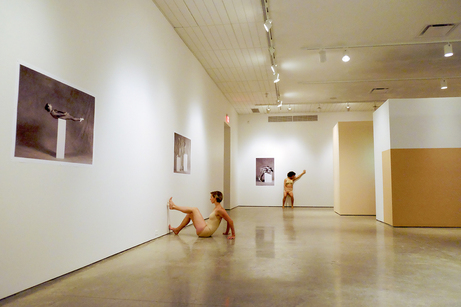
"Still Move," performance stills taken at Southern Alberta Art Gallery, Lethbridge, Canada, 2015. Courtesy of the artist and Monique Meloche Gallery, Chicago. Photo: Rod Leland Photography
Join us for the Chicago launch of Lost Bodies and Still Move, two new monographs on the work of artist Brendan Fernandes. David Getsy and Zach Stafford will join Fernandes in a conversation about his recent work. A book signing and reception will follow the discussion.
In his multimedia practice, Brendan Fernandes addresses a wide range of questions surrounding identity and expression, including the concept of queer bodies, the history of ballet as a cultural signifier—particularly in juxtaposition to African modes of visual and ritual art—and, more recently, the dance floor as a sacred space of freedom. Lost Bodies (Agnes Etherton Art Centre, Queen’s University, ON, 2016) and Still Move (Black Dog Press, London, 2017) explore these themes in depth.
Brendan Fernandes (b. 1979, Nairobi, Kenya, lives and works in Chicago) is a Canadian artist of Kenyan and Indian descent. He completed the Independent Study Program of the Whitney Museum of American Art (2007) and earned his MFA from the University of Western Ontario (2005) and his BFA from York University in Canada (2002). Fernandes has exhibited widely domestically and abroad, including exhibitions at the Solomon R. Guggenheim Museum, New York; Museum of Modern Art, New York; Museum of Art and Design, New York; Musée d'art contemporain de Montréal; The National Gallery of Canada, Ontario; The Brooklyn Museum, New York; The Studio Museum in Harlem, New York; Mass MoCA, North Adams, MA: The Andy Warhol Museum, Pittsburgh, PA; Deutsche Guggenheim, Berlin; Bergen Kunsthall, Norway; Stedelijk Museum, Amsterdam; The Sculpture Center, New York; The Quebec City Biennial; the Third Guangzhou Triennial in China; and Monique Meloche Gallery, Chicago.
Upcoming projects include a performance of Free Fall at The Getty, Los Angeles (June); a residency at Recess, New York (July); and a solo exhibition at Aljira Center for Contemporary Art, Newark, NJ(fall 2017). He is currently Artist in Residence and Faculty at Northwestern University in the Department of Art Theory and Practice, and is represented by Monique Meloche Gallery, Chicago.
David J. Getsy is the Goldabelle McComb Finn Distinguished Professor of Art History at the School of the Art Institute of Chicago. He has published seven books, most recently Abstract Bodies: Sixties Sculpture in the Expanded Field of Gender (Yale University Press, 2015) and the anthology of artists’ writings, Queer (MIT Press, 2016), which is a 2017 Lambda Literary Awards Finalist. He writes about histories of art and performance with an emphasis on queer and transgender topics and methods in modern and contemporary art, and his current projects pursue archive-based recoveries of forgotten queer and genderqueer performance practices in late-twentieth-century America.
Zach Stafford is the editor at large of Out Magazine and a contributing writer for The Guardian where he covers justice, violence and social issues. He regularly provides commentary on radio, podcasts, and has appeared on the BBC, CNN, and The Daily Show with Trevor Noah. Zach is also the co-editor of the bestselling book Boys, An Anthology (2013), and is currently touring his photo-essay project, When Dogs Heal, which explores the lives of HIV+ people and the pets that saved their lives.
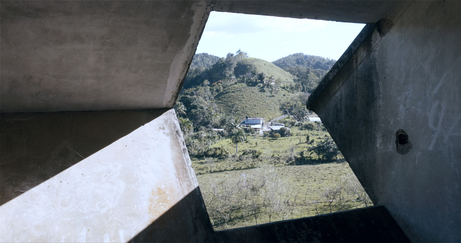
David Hartt, still from “in the forest,” 2017. 4K Digital Video File, color, sound; 20 min. Courtesy of Corbett vs. Dempsey and commissioned by the Graham Foundation for Advanced Studies in the Fine Arts.
Join us for a reception to celebrate the opening of in the forest, an immersive installation by artist David Hartt that revisits architect Moshe Safdie’s unfinished 1968 Habitat Puerto Rico project through a contemporary lens. Consisting of a newly commissioned film, a suite of photographs, and a series of sculptures, the exhibition continues Hartt’s investigation into the relationship between ideology, architecture, and the environment.
6-8:00 p.m. Opening Reception
6:00 p.m. Comments by David Hartt with Graham Foundation director Sarah Herda
For more information on the exhibition, in the forest, click here.
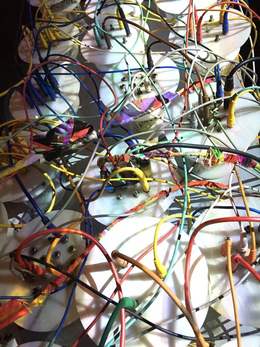
LoVid presents Mesh Extenders, a group of interconnected compositions made for their handmade analog synthesizers along with video—new work that constructs landscapes between virtuality, abstraction, and documentation of daily life.
The art duo’s A/V performances are live, immersive, visceral, audiovisual noise. Their synthesizers are designed to continue the legacy of artist-made tools. LoVid’s approach to instrument building is an exploration of the relationship between craft and engineering, embracing and integrating fragilities of analog systems into the instruments’ design, and audiovisual compositions. Aesthetically, the instruments are sculptural combinations of circuits, wires, and textiles. Combining material and media sheds light on handmade DIY technological tools that expand on the relationship between the human body and technological development as part of the artists’ practice.
Tali Hinkis (b.1974, Jerusalem, Israel) and Kyle Lapidus (b.1975, New York, N.Y.) have worked together as LoVid since 2001. Their work includes immersive installations, sculptural synthesizers, single channel videos, textile, participatory projects, mobile media cinema, works on paper, and A/V performance. Projects have been presented at ISSUE Project Room, New York; The Jewish Museum, New York; The Neuberger Museum, Purchase, New York; The New Museum, New York CAM Raleigh, North Carolina; Hors Pistes Tokyo Daejeon Museum of Art, Korea; Netherlands Media Art Institute; and ICA, London; among many others. LoVid has performed and presented works at The Kitchen, MoMA, PS1 and The Museum of the Moving Image, all in New York; Lampo, Chicago, International Film Festival Rotterdam, The Netherlands; CCA (Israel) and FACT (Liverpool). They have received support from several organizations and foundations. LoVid’s video works are distributed through Electronic Arts Intermix.
LoVid last appeared at Lampo in December 2010. They premiered C/O/L/O/R/G/B, performing with a new synthesizer color wheel. In Becoming One.2, LoVid invited guests to contribute body signals that were amplified by the duo’s circuit tacos.
Since 2010 the Graham Foundation has supported and partnered with Lampo to produce this performance series held at the Madlener House. Lampo, founded in 1997, is a non-profit organization for experimental music and intermedia projects. Additional support is provided by mediaThe foundation inc.; organized in cooperation with the School of the Art Institute of Chicago, Department of Art and Technology Studies and Department of Performance.
Related Graham Foundation supported projects:
2013 New Media Grant to LoVid for iParade (Chicago)
2016 New Media Grant to LoVid for iParade (Chicago)
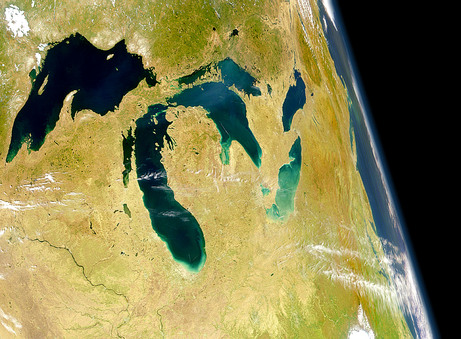
NASA Visible Earth, Great Lakes, 1999. Courtesy SeaWiFS Project, NASA/Goddard Space Flight Center and ORBIMAGE.
Join the Graham Foundation for a panel discussion and reception to celebrate the launch of Third Coast Atlas: Prelude to a Plan. This recent grantee publication describes the conditions for urbanization across the Great Lakes region and assembles a multi-layered, empirical description of urbanization processes within the drainage basins of the five Great Lakes and the Saint Lawrence River. This publication encompasses a range of representational forms including maps, plans, diagrams, timelines, and photographs, as well as speculative design research projects and critical texts. Postponing diagnosis, let alone treatment of these conditions, Third Coast Atlas aspires to simply describe. It proposes a new geographic gestalt for urban analysis. Superimposed upon the North American continent, and with easily recognizable yet divergent political and geological borders, this megaregion traverses portions of eight US states and two Canadian provinces, as well as the world’s largest collection of surficial fresh water. Third Coast Atlas characterizes the littoral edge as a distinct field of urbanization, and constructs a reading of the region both specific and speculative.
Daniel Ibañez is a practicing architect and urbanist, and founder and co-director of the design firm Margen-Lab. He is currently an instructor and doctor of design candidate at the Harvard GSD, editor of New Geographies, and researcher at the Urban Theory Lab. Ibañez’s research critically seeks to frame the design disciplines in relation to broader socio-ecological interdependencies through cross disciplinary research on the field of urban metabolism. Daniel is editor several book publications, including New Geographies, no. 6: Grounding Metabolism (HUP, 2014) and the Wood Urbanism: From Molecular to Territorial (forthcoming Actar, 2017). Also, since 2015, Daniel is editor at urbanNext.
Clare Lyster is an Irish architect, educator, and writer based in Chicago, Illinois, where she is associate professor at the University of Illinois at Chicago School of Architecture. She is principal of CLUAA, a research-based design office in Chicago operating at the intersection of architecture, landscape, and planning. In addition to her design practice, Lyster writes about architecture and urbanism from the perspective of contemporary theories in landscape, infrastructure, and globalization. She is author of Learning from Logistics: How Networks Change Cities (Birkhauser, 2016); co-editor of 306090_09, Regarding Public Space (PA Press, 2005); and Envisioning the Bloomingdale, (Chicago Architecture Club,2009). She is the 2017 Gillmor Lecturer at the University of Calgary.
Charles Waldheim is a Canadian-American architect and urbanist based in Cambridge, Massachusetts. Waldheim’s research examines the relationships between landscape, ecology, and contemporary urbanism. He is author, editor, and co-editor of numerous books on these subjects, and his writing has been published and translated internationally. Waldheim is John E. Irving Professor of Landscape Architecture at the Harvard University Graduate School of Design where he directs the school’s Office for Urbanization. Waldheim is recipient of the Rome Prize Fellowship from the American Academy in Rome; the Visiting Scholar Research Fellowship at the Study Centre of the Canadian Centre for Architecture; and the Sanders Fellowship at the University of Michigan.
Mason White is a Canadian-American architect and urbanist based in Toronto, Ontario. White is founding partner of Lateral Office, a Toronto-based experimental design practice that operates at the intersection of architecture, landscape, and urbanism. In addition to his practice, White is associate professor at the Daniels Faculty of Architecture, Landscape, and Design at the University of Toronto. He is recipient of the Emerging Voices and Young Architects Prize from the Architectural League of New York; the Wheelwright Fellowship from the Harvard University Graduate School of Design; the Friedman Visiting Professorship at the University of California, Berkeley; and the Lefevre Fellowship at The Ohio State University. White is co-editor of Bracket, vol. 1 and co-editor of Pamphlet Architecture, no. 30: Coupling—Strategies for Infrastructural Opportunism.
Philip Enquist is Partner in Charge of Urban Design and Planning SOM and the leader of its Global City Design Practice. The scale of Enquist’s design perspective encompasses from innovating sustainable urban forms that enhance city living with walkable, transit-enabled districts humanized by their natural amenities to rapidly changing urban clusters within regional ecosystems like North America’s Great Lakes basin and China’s Bohai Rim. He has taught at Harvard University’s Graduate School of Design, and as the Charles Moore Visiting Professor at the University of Michigan’s Taubman College of Architecture and Urban Planning. He was honored with the 2010 Distinguished Alumnus Award from the Architectural Guild of the University of Southern California's School of Architecture for his dedication to strengthening the physical, social, and intellectual infrastructure of cities and in 2009 Chicago Tribune named him and his studio as one of the "Chicagoans of the Year in Architecture."
Martin Felsen co-founded UrbanLab in 2000 and is an Associate Professor in the Illinois Institute of Technology’s (IIT) College of Architecture. Martin received the Dubin Family Young Architect Award in 2007 from the American Institute of Architects (AIA) Chicago. Also in 2007 UrbanLab was named as the national winner of the History Channel’s “City of the Future” competition for a proposal titled “Growing Water.” UrbanLab won the American Institute of Architects (AIA) College of Fellows Latrobe Prize in 2009, and UrbanLab’s architecture and urban design projects have won several design awards from the AIA. In 2010 UrbanLab was included in the Emerging Voices lecture series sponsored by the Architectural League. In 2012, UrbanLab exhibited work at the Venice Biennale in "Common Ground" curated by David Chipperfield, and in 2015, UrbanLab exhibited "Filter Island" at the Chicago Biennial. Publications presenting UrbanLab’s design and research work include Architecture, Architectural Record, the New York Times and the Chicago Tribune. He is co-author, with Sarah Dunn of the book, Bowling: Water, Architecture, Urbanism, which investigates the symbiotic relationships between architectures of quality and infrastructures of quantity in Chicago, New York, and the Sun Belt.
James Wasley is a Director of the Institute for Ecological Design and the former Chair of the Department of Architecture at UWM. Professor Wasley’s current research is in the creation of ecological urban waterscapes at a variety of scales. Since 2011 he has led the school-wide Milwaukee Inner Harbor Project, which has explored the redevelopment and ecological restoration of the 200+ acres of brownfields surrounding the Port of Milwaukee. This has in turn led to a suite of ten demonstration projects on the harbor at the UWM School of Freshwater Sciences that are moving towards implementation. Professor Wasley teaches architectural design studios and professional practice seminars from an ecological perspective.
Related Graham Foundation supported projects:
2015 Publication Grant to Daniel Ibañez, Clare Lyster, Charles Waldheim, and Mason White for Third Coast Atlas: Prelude to a Plan of The Great Lakes Region
2014 Publication Grant to Clare Lyster for Learning from Logistics: How Networks Change Our Cities
2014 Publication Grant to Lola Sheppard and Mason White for Many Norths: Spatial Practices in a Polar Territory
2014 Publication Grant to InfraNet Lab (Neeraj Bhatia and Mason White) for Bracket 4 [Takes Action]
2014 Publication Grant to Harvard Graduate School of Design for New Geographies 07: Information Geographies and New Geographies 08: Islands
2013 Exhibition Grant to Harvard Graduate School of Design for Airport Landscape: Urban Ecologies in the Aerial Age (Sonja Dümpelmann and Charles Waldheim, curators)
2001 Grant to the University of Illinois at Chicago for Chicago Architecture: Histories, Revisions, Alternatives (Katerina Rüedi Ray and Charles Waldheim, authors)
1999 Grant to Georgia Daskalis, Charles Waldheim, and Jason Young for Stalking Detroit
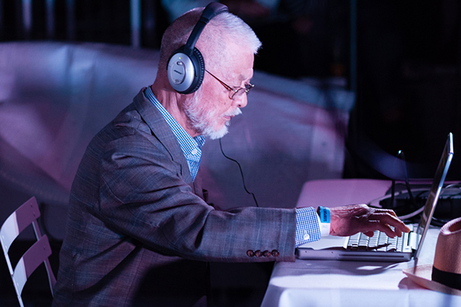
Artist, writer, theorist, and composer Yasunao Tone presents new work embracing artificial intelligence (AI).
Tone has collaborated with Professor Tony Myatt, University of Surrey, UK, and a team of researchers including Mark Fell and Dr. Paul Modler, with the support of the Issue Project Room. A series of performances using Tone’s MP3 Deviation software were captured in a laboratory then used to train Kohoen Neural Networks to develop artificial intelligences (AIs) that can simulate several of his performance approaches. The AIs are integrated in a software framework and computer performance system that extracts attributes from the audio they generate to “listen” to the output and make performance actions as if they were virtual Tone performers. Five versions of Tone AI exist in the performance software, each of which exhibits certain responses modeled on those previously adopted by Tone.
For Lampo, Tone performs AI Deviation V1#7 and AI Deviation V2#2.
In concert Tone deviates and controls AI versions of himself along with the mechanisms that each AI uses to hear and respond to the audio they generate—corrupting the technologies designed to simulate his own performances, and interacting live with AI versions of himself as performer.
Yasunao Tone (b.1935, Tokyo, Japan) has been active in creating event works and experimental music since the 1960s and has been an organizer and participant in Fluxus, Group Ongaku, Hi-Red Center, and Team Random (Japan’s first computer art group). His work typically employs random events and indeterminate compositional techniques. Tone coined the term “paramedia art” to describe his work, and his artistic inventions include prepared CD and interventions with an MP3 system. Primarily a composer, Tone has worked in many media, creating pieces for electronics, computer systems, film, radio, and television, as well as environmental art. His work is distinguished by conversion of text into music via images with analog and digital means, and with a critique of the medium in use. Tone has presented concerts at The Kitchen, The Museum of Modern Art, and the Guggenheim Museum, all in New York; Museum of Contemporary Art, Barcelona; the Ars Electronica Festival, Linz; Centre Pompidou, Paris; Sonic Lights, Amsterdam; and ATP festivals and Lovebytes festivals, UK, among many others. Honors include the Ars Electronica Golden Nica prize and the Foundation for Contemporary Arts award in music.
Yasunao Tone presented his Paramedia Mix and Wounded Kanji Dictionary at Lampo in April 2007. He also performed in the Lampo series in November 2002, joined by Florian Hecker in the duo’s first US concert.
Since 2010 the Graham Foundation has supported and partnered with Lampo to produce this performance series held at the Madlener House. Lampo, founded in 1997, is a non-profit organization for experimental music and intermedia projects.
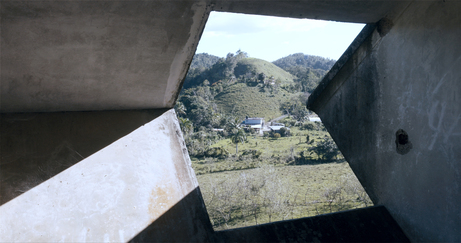
David Hartt, still from “in the forest,” 2017. 4K Digital Video File, color, sound; 20 min. Courtesy of Corbett vs. Dempsey and commissioned by the Graham Foundation for Advanced Studies in the Fine Arts.
Join the Graham Foundation for an artist talk and reception with David Hartt in conjunction with his current exhibition, in the forest, which revisits architect Moshe Safdie’s unfinished 1968 Habitat Puerto Rico project through a contemporary lens. The exhibition continues Hartt’s investigation into the relationship between ideology, architecture, and the environment. in the forest is on view at the Foundation from September 14, 2017–January 6, 2018.
David Hartt (b. 1967, Montréal) lives and works in Philadelphia where he is Assistant Professor in the Department of Fine Arts at the University of Pennsylvania. Recent solo exhibitions have been held at The Art Institute of Chicago; LA><ART, Los Angeles; and Or Gallery, Vancouver. Additionally, his work has been included in several group exhibitions including Ocean of Images: New Photography 2015 at The Museum of Modern Art, America Is Hard to See at the Whitney Museum of American Art, and Shine a light/Surgir de l’ombre: Canadian Biennial at the National Gallery of Canada. His work is in the public collections of The Museum of Modern Art, New York; Whitney Museum of American Art, New York; The Studio Museum in Harlem, New York; The Art Institute of Chicago; Museum of Contemporary Art, Chicago; The Museum of Contemporary Photography, Chicago; Henry Art Gallery, Seattle; The National Gallery of Canada, Ottawa; and The Stedelijk Museum, Amsterdam. Hartt is the recipient of a 2015 Foundation for Contemporary Art Grant. In 2012 he was named a United States Artists Cruz Fellow and in 2011 he received a Louis Comfort Tiffany Foundation Award. Hartt is represented by Corbett vs. Dempsey, Chicago; David Nolan Gallery, New York; and Galerie Thomas Schulte, Berlin.
|
At present, the people of Puerto Rico continue to face a humanitarian crisis following the devastation left in the wake of hurricane Maria. People are still without access to food, clean water, power, and other daily necessities, and they face the daunting work ahead to rebuild their communities. If you would like to help, please consider donating to relief efforts at the link below: |
To learn about additional ways to help, Americans for the Arts has organized a list of trusted organizations on their website, which can be accessed here.
For more information on the exhibition, in the forest, click here.

Habitat Puerto Rico, model showing terraces and view from walkway system, 1968. Courtesy Safdie Architects
Capacity is limited; the event will also be live streamed here.
Please note that seating for this event is on a first-come, first-served basis. Registration is required but does not guarantee entry. Doors open 30 minutes prior to the lecture for those registered in advance. Reservations expire 5 minutes before the start time, at which point seating will be released to the waitlist. Overflow viewing areas will be available on the first and second floors of the building.
The Graham Foundation is pleased to present a talk by Moshe Safdie in celebration of the 50th anniversary of the architect’s design for Habitat ’67 in Montreal. Completed early in his career, this project initiated a series of Habitat housing developments in New York, Israel, San Juan, and Singapore, among other cities that strove to foster new forms of community—bringing together nature, culture, and privacy within the city. Safdie discusses the unique challenges of the Habitat projects, as well as how these ideas have continued to inform and shape his contemporary practice.
This talk coordinates with the Graham’s presentation of David Hartt’s exhibition in the forest, a meditative installation and film, which investigates Safdie’s unfinished Habitat Puerto Rico as it stands today.
Moshe Safdie is an architect, urban planner, educator, theorist, and author. Over a celebrated 50-year career, Safdie has explored the essential principles of socially responsible design with a distinct visual language. A citizen of Israel, Canada, and the United States, Moshe Safdie graduated from McGill University. After apprenticing with architect Louis Kahn in Philadelphia, Safdie returned to Montréal, established his own firm in 1964, and realized Habitat ’67—a key component of the master plan for the 1967 World Exhibition. The innovative residential complex Habitat ’67, an adaptation of Safdie's undergraduate thesis, marked a turning point in modern architecture. Author of four books and a frequent essayist and lecturer, Safdie’s global practice includes work in North and South America, the Middle East, and throughout Asia and Australia. Projects span a wide range of typologies, including airports, museums, performing arts, libraries, housing, mixed use, and entire cities. His honors include the Companion of the Order of Canada; the Gold Medal from both the Royal Architectural Institute of Canada and the American Institute of Architects; la Medaille du Merite from the Order of Architects of Quebec, Canada; and Israel’s Rechter Prize. The Cooper Hewitt, Smithsonian Design Museum awarded Mr. Safdie the National Design Award for Lifetime Achievement in 2016.
The first floor of the Madlener House is accessible via an outdoor lift. Talks are held in the ballroom on the third floor, which is only accessible by stairs. Please call 312.787.4071 to make arrangements.
|
At present, the people of Puerto Rico continue to face a humanitarian crisis following the devastation left in the wake of hurricane Maria. People are still without access to food, clean water, power, and other daily necessities, and they face the daunting work ahead to rebuild their communities. If you would like to help, please consider donating to relief efforts at the link below: |
To learn about additional ways to help, Americans for the Arts has organized a list of trusted organizations on their website, which can be accessed here.
For more information on the exhibition, in the forest, click here.
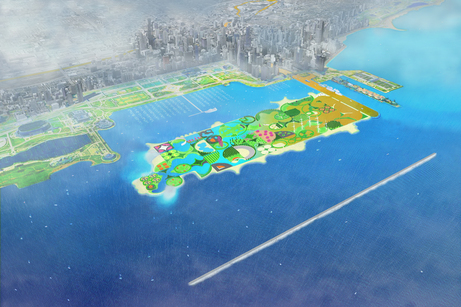
Filter Island, positioned between the Chicago River and Lake Michigan, Chicago
UrbanLab will present their new Graham funded book, Bowling: Water, Architecture, Urbanism, which investigates the symbiotic relationships between architectures of quality and infrastructures of quantity in Chicago, New York, and the Sun Belt. The book is a conjecture of what a comprehensible city could be to combat (real and predicted) natural crises—through design-based analysis and experimentation.
UrbanLab is an architecture and urban design office cofounded by Sarah Dunn and Martin Felsen. The practice blends design and research to produce uniquely progressive, site-specific projects, resulting in a new aesthetic for environmentally resilient architecture, landscapes, and public space. The office’s realized projects range in scale from small houses to urban districts.
Sarah Dunn received her BA from Columbia College and her MArch from the Graduate School of Architecture, Planning and Preservation at Columbia University. Dunn is a partner in the architecture and urban design firm UrbanLab in Chicago. UrbanLab won the AIA College of Fellows Latrobe Prize (2009), was selected as an Emerging Voice by the Architectural League of New York (2010), and exhibited at the Venice Biennale (2012) and the Chicago Architecture Biennial (2015). Dunn is also an associate professor at the University of Illinois at Chicago.
Martin Felsen received his BArch from Virginia Tech and his MS from the Graduate School of Architecture, Planning and Preservation at Columbia University. Felsen is a licensed architect and a partner in the architecture and urban design firm UrbanLab in Chicago. Felsen is an associate professor at the Illinois Institute of Technology, College of Architecture. Felsen serves on the Board of Places Journal Foundation, the Board of Archeworks, and the Editorial Advisory Board of The Architect's Newspaper.
Related Graham Foundation supported project:
2014 Publication Grant to Sarah Dunn & Martin Felsen Bowling: Water, Architecture, Urbanism
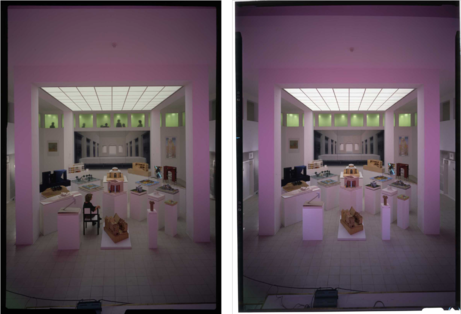
Atelier Markgraph, photograph for cover of Nouveau Plaisirs d’architectures catalog (1984)
Oliver Elser, historian and curator, will present his lecture Models of Postmodernism–Postmodernisms Models. Elser will examine the founding of the Deutsches Architekturmuseum in Frankfurt in 1984. His lecture focuses on German architectural collector and founder Heinrich Klotz, and architect Oswald Mathias Ungers and their collaboration to produce a model museum in a historic villa.
Oliver Elser is a curator at the Deutsches Architekturmuseum (DAM) in Frankfurt, Germany. His practice includes criticism, teaching, and archival based exhibition making. After studying architecture at the Technical University of Berlin, Elser worked in Vienna as an architecture critic and journalist, publishing often in Der Standard, Architectural Digest, and profil. He has taught scenography at the University of Applied Sciences in Mainz and has shown work at the 2013 Venice Biennale in the exhibition Il Palazzo Enciclopedico. Exhibitions that he has curated include: The Architecture Model: Tools, Fetish, Small Utopia, DAM (2012); The 387 Houses of Peter Fritz, Venice Art Biennale (2013); Mission: Postmodern. Heinrich Klotz and the Wunderkammer, DAM (2014); Making Heimat. Germany, Arrival Country, German Pavilion at the Venice Architecture Biennale (2016); and SOS BRUTALISM – Save the Concrete Monsters!, DAM (2017).
This program is presented in partnership with the 2017 Chicago Architecture Biennial.
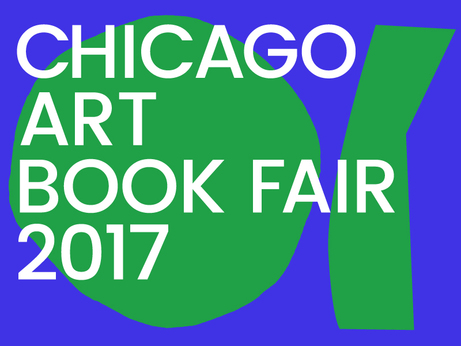
Chicago Architecture Biennial Rooms for Books
Chicago Cultural Center
77 E Randolph Street, Chicago, IL 60601
Join us for a day-long series of programs presented by the Graham Foundation Bookshop and the Chicago Art Book Fair in the Rooms for Books at the Chicago Architecture Biennial. Throughout the afternoon, three exhibitors in the Book Fair will share current work and reflect on the conceptual process and physical project of making and designing books.
PROGRAM OF EVENTS
Bricks from the Kiln #3 Listening Preview
12:30 p.m.
Andrew Lister and Matthew Stuart give a multimedia preview of the third issue of Bricks from the Kiln with a four-part audio installation in each of the Rooms for Books quadrants.
The Managerial Arts of Books and Prosthetics with Soberscove Press
3:30 p.m.
On the occasion of Soberscove Press’ release of its new title, The Hysterical Material, designer David Khan-Giordano and editor Geof Oppenheimer discuss their approach to the art of catalog production with publisher Julia Klein.
The London Centre for Book Arts Show-and-Tell
5:00 p.m.
Ira Yonemura and Simon Goode describe the work of the London Centre for Book Arts and situate their practice within contemporary publishing in the UK.
PARTICIPANTS
Bricks from the Kiln, edited and designed by Andrew Lister and Matthew Stuart between Chicago and London, borrows its title from the glossary notes of Ret Marut's Der Ziegelbrenner, which was the 'size, shape and colour of a brick,' and ran for 13 issues between 1917 and 1921. Each issue of Bricks from the Kiln is ‘tentative, incomplete and inconsistent’ and ‘in flux and liable to crack.’
Soberscove Press seeks to make available art-related materials that fill a gap in the literature or are difficult to access (e.g. out-of-print, not in translation, previously unpublished, or limited in circulation). Their books tend to explore modes and functions of documentation and connect historical themes and issues to the present.
David Khan-Giordano lives and works in Chicago.
Geof Oppenheimer is an Associate Professor of Practice in the Arts at the University of Chicago. His practice takes up questions of civic value, the ways in which political and social structures are encoded in images and objects and how meaning is formed in the modern world.
The London Centre for Book Arts (LCBA) is an artist-run, open-access studio providing education programmes for the community and access to resources for artists, designers and makers.
PARTNERS
The Chicago Art Book Fair is dedicated to showcasing emerging directions and diverse legacies within small press arts publishing. The fair features an international group of over 100 arts publishers, small presses, book artists, comics artists, zinemakers and printmakers. The fair takes place from November 16–19 in the Chicago Athletic Association, and will also feature satellite programming and after parties. CABF is free and open to the public.
Rooms for Books is an installation conceived by MG&Co. for the 2017 Chicago Architecture Biennial. It transforms the traditional bookshop into a platform for reflection and for the presentation, documentation, production, and dissemination of the architecture book.
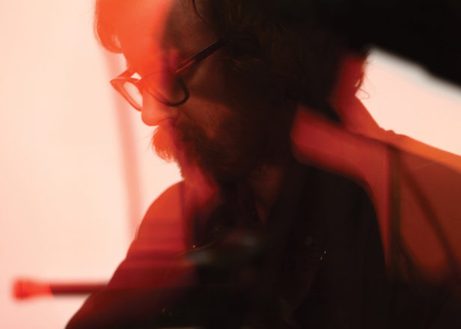
Photo by Martin Escalante
John Wiese returns to Lampo to perform his new four-channel composition Time Column—a work that the Los Angeles-based artist says “imposes vertical time on horizontal sounds.”
John Wiese (b.1977, Ft. Leavenworth, KS) works primarily in recorded and performed sound with a focus on installation and multi-channel diffusions, as well as scoring for large ensembles. He is a prolific artist with various ongoing projects, including the concrète grindcore band Sissy Spacek, and collaborations with Evan Parker, C. Spencer Yeh, Aaron Dilloway, Kevin Drumm, Lasse Marhaug and others. In 2011 he released his 100th 7-inch record, celebrated with a retrospective exhibit and monograph. Many of these recordings were published on his Helicopter label, and on more than 50 independent labels from around the world. Wiese has toured extensively and has appeared at several leading international festivals.
In May 2012 John Wiese performed three new works for Lampo—a quad diffusion of Magical Crystal Blah, a new version of Battery Instruments, and a concrète improvisation.
Since 2010 the Graham Foundation has supported and partnered with Lampo to produce this performance series held at the Madlener House. Lampo, founded in 1997, is a non-profit organization for experimental music and intermedia projects.
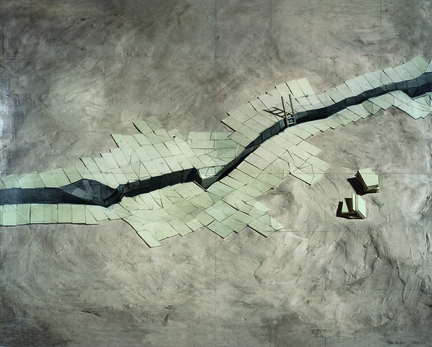
Allan Wexler, Sheathing the Rift, 2014, hand-worked inkjet on panel, 64 x 80 inches
Architect, artist, and designer Allan Wexler discusses his multi-scalar, multi-media work across a 45-year career. Allan reveals a curious, comedic, and analytical mind, offering new strategies for examining and reevaluating basic assumptions about our relationship to the built and natural environments.
Wexler's work mediates the gap between fine and applied art. Sometimes functional—tangible and tactical—sometimes theoretical, his work is often a hybrid of function and theory. In all cases, it demonstrates a commitment to reevaluating basic assumptions about what we thought we knew. Wexler's art can be broadly described as tactile poetry that is composed by reframing the ordinary with intent to sustain a narrative about landscape, nature, and architecture.
The lecture coincides with the publication of Absurd Thinking, Between Art and Design, a new monograph edited by Ashley Simone and published by Lars Müller Publishers with support from the Graham Foundation.
Allan Wexler works in the fields of architecture, design, and fine art. He is represented by the Ronald Feldman Gallery in New York City and has exhibits, teaches, and lectures internationally. Wexler teaches at Parsons School of Design in New York City. Wexler is a recipient of a Guggenheim Fellowship (2016), a Fellow of the American Academy in Rome, and a winner of both a Chrysler Award for Design Innovation, and the Henry J. Leir Prize from the Jewish Museum. He has had numerous national and international solo exhibitions, has lectured on his work internationally, and has been reviewed by major art and architecture publications. The subject of Wexler's work is the built environment. He creates drawings, multimedia objects, images, and installations that alter perceptions of domestic activities. He investigates eating, bathing, sitting, and socializing, and turns these everyday activities into ritual and theater.
Related Graham Foundation supported projects:
2016 Publication Grant to Allan Wexler for Absurd Thinking: Between Art and Design
Unless otherwise noted,
all events take place at:
Madlener House4 West Burton Place, Chicago
GALLERY AND BOOKSHOP HOURS
2025 Chicago Architecture Biennial
SHIFT: Architecture in Times of Radical Change
Sep 19, 2025–Feb 28, 2026
Wed–Sat, 12–5 p.m.
HOLIDAY HOURS: the galleries and bookshop are closed Dec 24, 2025 through Jan 3, 2026
Regular hours resume on Jan 7, 2026
CONTACT
312.787.4071
info@grahamfoundation.org
Accessibility
Events are held in the ballroom on the third floor which is only accessible by stairs.The first floor of the Madlener House is accessible via an outdoor lift. Please call 312.787.4071 to make arrangements.
Copyright © 2008–2026 Graham Foundation. All rights reserved.